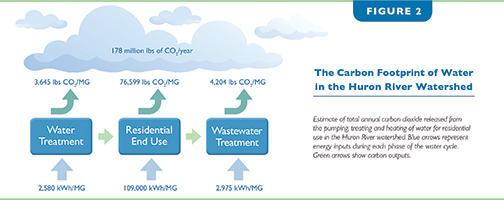Water utilities and residents within the Huron River watershed contribute approximately 178 million lbs of CO2 annually through the production, use and treatment of drinking water. This is equivalent to the annual emissions from nearly 17,000 passenger vehicles. It takes more than double the combined areas of the Pinckney and Waterloo Recreation Areas to sequester this much carbon each year.
My guess is most of you have not thought about water use as a contributor to climate change. Before undertaking this analysis, I had not. But over the course of the past two years, through a project supported by the Masco Corporation Foundation, HRWC has been able to research and calculate the carbon footprint of our water use here in the watershed.
A new report shares our findings. The Carbon Footprint of Domestic Water Use in the Huron River Watershed follows water from its source through water treatment, residential water use and wastewater treatment to discharge back into the environment. At each point in the cycle, energy is used. Energy is needed to pump, treat and heat water and energy use results in the release of CO2 and other greenhouse gases to the atmosphere.
What did we learn?
- Energy used to produce drinking water in the watershed is about 10% higher than national averages.
- Energy used to treat wastewater in the watershed is 57-76% higher than national averages depending on treatment type.
- Energy used in homes for water use was lower than national averages but by far the most energy intense phase of the cycle in the watershed.
What this tells us is that there is room for improvement both among water utilities and residents of the Huron River watershed. There was a lot of variation in the efficiency of local water utilities. Future efforts can target utilities that use the most energy per unit of water produced or treated. Improving efficiencies at these utilities can lead to significant reductions in our collective carbon footprint.
That said, the greatest gains that can be made are within your power. Reducing the amount of hot water used in the home is the single greatest strategy for reducing greenhouse gas emissions associated with water use. And, by doing so, households will also see reductions in both water and energy bills. It is a win-win-win situation. Save water. Save energy. Save money.
What can we do?
There are many sources of information and tips on how to reduce water use in homes. Pick a few tricks that work for you and get started. It is another way that you can take personal actions that contribute to the well being of the planet and all its inhabitants.
- Take a look at HRWC’s H20 Heroes webpage for water saving tips
- When purchasing new appliances, look for the WaterSense label
- Calculate your current water use and see how changes you make lower your impact using a water calculator.
Often overlooked when identifying ways to reduce carbon emissions, water conservation holds the potential for significant gains in reducing a community’s contribution to global climate change and something individuals and families can take on to reduce their carbon footprint. So get started today. And share with us in the comments how you are becoming an H20 Hero!




